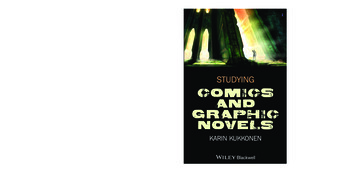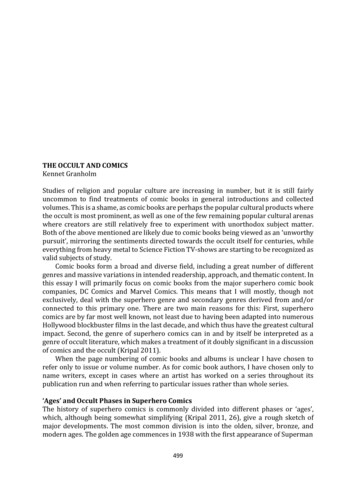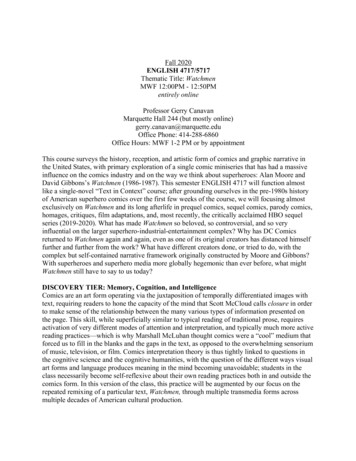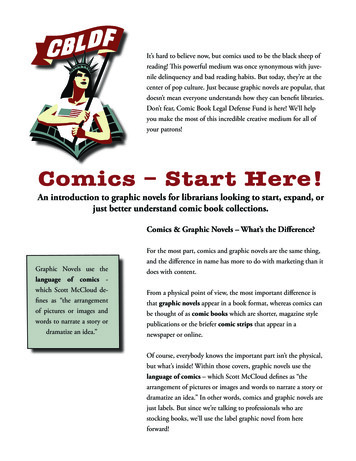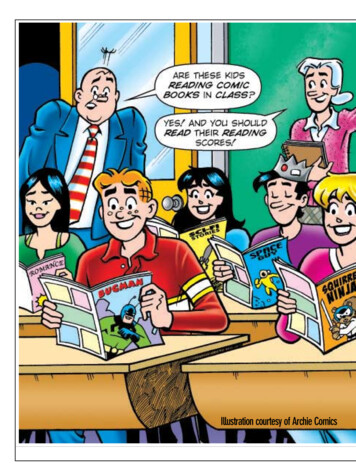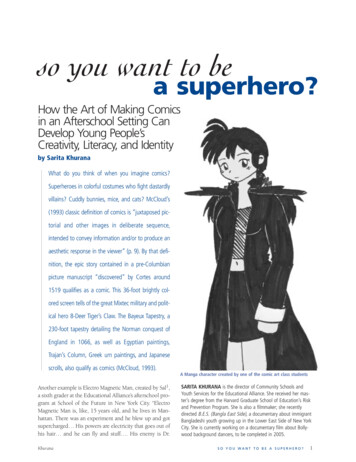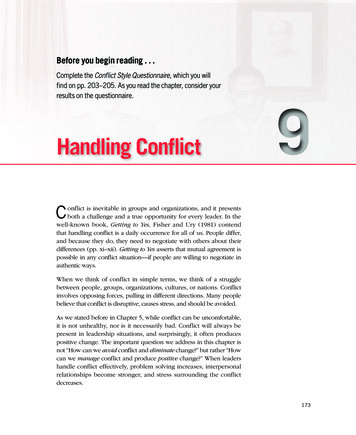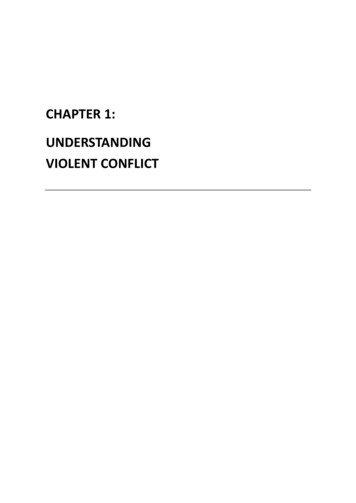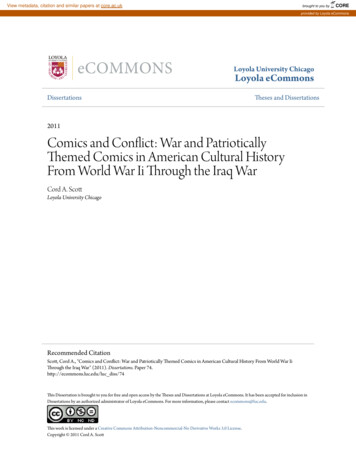
Transcription
View metadata, citation and similar papers at core.ac.ukbrought to you byCOREprovided by Loyola eCommonsLoyola University ChicagoLoyola eCommonsDissertationsTheses and Dissertations2011Comics and Conflict: War and PatrioticallyThemed Comics in American Cultural HistoryFrom World War Ii Through the Iraq WarCord A. ScottLoyola University ChicagoRecommended CitationScott, Cord A., "Comics and Conflict: War and Patriotically Themed Comics in American Cultural History From World War IiThrough the Iraq War" (2011). Dissertations. Paper 74.http://ecommons.luc.edu/luc diss/74This Dissertation is brought to you for free and open access by the Theses and Dissertations at Loyola eCommons. It has been accepted for inclusion inDissertations by an authorized administrator of Loyola eCommons. For more information, please contact ecommons@luc.edu.This work is licensed under a Creative Commons Attribution-Noncommercial-No Derivative Works 3.0 License.Copyright 2011 Cord A. Scott
LOYOLA UNIVERSITY CHICAGOCOMICS AND CONFLICT: WAR AND PATRIOTICALLY THEMED COMICSIN AMERICAN CULTURAL HISTORYFROM WORLD WAR II THROUGH THE IRAQ WARA DISSERTATION SUBMITTED TOTHE FACULTY OF THE GRADUATE SCHOOLIN CANDIDACY FOR THE DEGREE OFDOCTOR OF PHILOSOPHYPROGRAM IN HISTORYBYCORD A. SCOTTCHICAGO, ILLINOISAUGUST 2011
Copyright by Cord A. Scott, 2011All rights reserved.
ACKNOWLEDGEMENTSThis dissertation is not the product of a single person, but also reflects thecontributions of many who helped in its creation and refinement. While the final result(and mistakes) are mine alone, I was assisted by many people whose help and input mustbe acknowledged.I would like to thank Darlene Ulmer, Ron Wade, and Mark Holroyd from IADTChicago for their encouragement to write and teach the two classes (History ofPropaganda, and History of Comic books) that led to this project. They were great bossesat a crucial time in my academic career.I also wish to thank my research committee for their assistance. Dr. LewisErenberg (my advisor), Dr. Susan Hirsch, Dr. Ted Karamanski, and Dr. Tim Gilfoyle, allplayed important roles in the completion of this dissertation. Lillian Hardison and TriciaClemente deserve special thanks for making the system hum along with efficiency, asdoes Kurt Klein for editing the text to its proper style and format.Sections of this dissertation were previously published in the Journal of PopularCulture (Spring 2007), the International Journal of Comic Art (Fall 2008), CaptainAmerica and the Struggles of the Superhero: Critical Essays, edited by Robert Weiner(Spring 2009), and the Greenwood Encyclopedia of Comics and Graphic Novels (Spring2010).iii
My colleagues have served a critical role in developing my thoughts andconcepts. In particular, Kevin Kaufman, Pat Mallory, Stella Ress, Dejan Kralj, and JayWard have all prodded me along when I needed it. Lee and Cindy Windsor gave me anentirely new perspective on how look at comic books while on a battlefield tour of Italy.To them and many others I again say thanks.My family served as a source of strength, especially during the many times whenI felt like chucking the entire process and walking away. Jerry and Renee Scott offeredencouragement and suggestions. Micah Scott has never ceased to amaze me with his keenobservations of my work (his intelligence and talent always confound me). Paul Macheoffered great comments and the great break for other topics when needed.However, my greatest thanks must go to the corps of ―Wonder Women‖ who gotme through this. Lauren Mache gave me positive thoughts and observations as she wentthrough the dissertation process twice. My daughters Zia and Jayna pointed out all sortsof ―odd things,‖ yet let dad work when needed. Peggy Smetana and Linda Scott read andre-read so many versions of this project that they almost deserve co-author credit. Finally,Rachel Mache served as my muse, inspiration, and drive when I was incredibly boggeddown in the writing. I cannot express my gratitude to these pillars of strength. I only hopethat I have done them proud.iv
This dissertation is dedicated to my loved oneswho could not live to see it completed,and to those who can.
TABLE OF NPatriotismPropaganda156CHAPTER 1: ENTERTAINING AND INFORMING THE MASSESThe History of the MediumWorld War I and Cartoon IllustrationsThe Interwar PeriodThe Need for Entertainment in the DepressionThe Comics ExpandComic Books and the Fascist ThreatEquity and Comic Book WorkThe Shift to War131419212433343842CHAPTER 2: FIGHTING FOR FREEDOM (1939-1945)Calls for United States Entry into the WarComic Books after United States Entry into the WarComic Books During World War IIConversion Themes in Comic Book CharactersFemale SuperheroesThe Use of Children in CombatGovernment Involvement in Comics and CartoonsDepictions of the Enemy444547515468697278CHAPTER 3: THE COLD WAR ERUPTS, AND COMICS—MOSTLY—TOE THE LINE (1945-1962)The Post–World War II YearsHistorical Comics of the Cold War and KoreaDr. Wertham and the Comics CodeWar and Patriotic Comics Under the CodeDell‘s Influence on War ComicsComics Produced for the United States MilitarySocial Issues in War Comics838490102105111116117CHAPTER 4: WAR COMICS IN A TIME OF UPHEAVAL (1962-1991)Pro-War ComicsAnti-War ComicsMainstream Comic Books Respond to VietnamPost-Vietnam and the Role of Minorities in War Comics122123129137140vi
Vietnam War Comics and Analysis, Twenty Years LaterWar Comics in the Reagan EraThe Bastardization of the Patriotic HeroAnti-War Comics and Realism142148154156CHAPTER 5: THE RESURGENCE OF SUPERHEROES AFTER THE FALLOF COMMUNISM (1991-2001)Changes to the ‘NamPunisher vs. Captain AmericaThe Mid-1990s and the New World Order in Comic BooksViolence in War ComicsWar Comics as ―News‖158165168182187195CHAPTER 6: THE ROLE OF COMICS AFTER 9/11 (2001-2003)Depictions of the AttackCaptain America and His Iconic RootsTraditional Roles within War Comics, Revisited or CorrectedAnti-War Comic Books Just Before the Iraq Invasion200204213217227CHAPTER 7: COMICS AND THE SOUL OF COMBAT (2003-2010)The World War II Comic, RevisitedPatriotic Themes and the Death of Captain AmericaComics for the TroopsConflict and Comics in Recent YearsChildren in Recent War Comics231238252260263265CONCLUSIONS: CONCEPTS OF WAR THROUGH COMICS269APPENDIX A: THE COMICS CODE274APPENDIX B: COMIC BOOK CREATOR BIOGRAPHIES279BIBLIOGRAPHY284VITA317vii
ABSTRACTIllustration has been an integral part of human history. Particularly before theadvent of media such as photography, film, television, and now the Internet, illustrationsin all their variety have been the primary visual way to convey history. The comic book,which emerged in its modern form in the 1930s, was another form of visual entertainmentthat gave readers, especially children, a form of escape.As World War II began, however, comic books became an integral part of warpropaganda as well providing information and education for both children and adults.This dissertation looks at how specific comic books of the war genre have been used todisplay patriotism, adventure through war stories, and eventually to tell of the horrors ofcombat—from World War II through the current conflicts in Iraq and Afghanistan in thefirst decade of the twenty-first century.This dissertation also examines how war- and patriotically-themed comicsevolved from soldier-drawn reflections of society, eventually developing along with thebroader comic book medium into a mirror of American society during times of conflict.These comic books generally reflected patriotic fervor, but sometimes they advanced aspecific cause. As war comic books evolved along with American society, many alsoserved as a form of protest against United States foreign and military policy. During theviii
country‘s most recent wars, however, patriotism has made a comeback, at the same timethat the grim realities of combat are depicted more realistically than ever before.ix
INTRODUCTIONPopular culture is a curious subject for history as customarily defined. Until thewidespread availability of inexpensive reproductions and printed texts, beginning in thesixteenth century in the West, relatively few artifacts of popular culture survived for laterhistorical analysis. Traditional history was largely based on what past elites believed wasworth saving, and for earlier periods it still is. Even supplemented by random survivals,and often hard-to-interpret archaeological remains, such histories necessarily reflect theideologies of those at the apex of power. Scholars working centuries later, and with quitedifferent ideologies, remain restricted by the extant sources. By contrast, popular culturalhistory draws on a broader base of materials and a more complete record, especially forthe past two centuries (a period roughly coterminous with the existence of the UnitedStates of America). Thus, as historical subjects get closer to the present and the depth andbreadth of evidence expands, it is increasingly possible to write history that reconstructsthe mental universe in which ordinary people lived.A major part of this record consists of popular narrative forms, which reflect—ina less self-conscious way than elite writing and art—the beliefs, hopes, aspirations, andfears that shaped humanity‘s past. In short, the materials of cultural history are exactlythose that had previously been unavailable or underappreciated by conventional methodsof historiography. What might seem to be simple, ephemeral stories, originally intended1
2for rapid disposal after their particular historical moment had passed, may instead offertoday‘s historians unique insight into the mindset of their readers. This wider culture,here represented by the comic book, cannot be captured entirely by the reigningideologies. It is too big and various to police effectively, and much of the time it occurs―under the radar.‖ Even after mainstream historians analyze it, some part of popularculture always escapes control, representing a relatively unfiltered record of the past.Among popular narratives, comic books are particularly revealing, as they directly reflecttheir audience‘s fantasies, nightmares, and delusions.Comic books often conceal secret gems of historical import. At their beginningand for a long time afterward, war comics depicted combat in heroic terms: noble causes,courageous soldiers, and the ―good death.‖ Deliberately suppressed were the harsherrealities of combat: cowardice, low morale, illness, and madness. Writers of comics didnot reconcile these inconsistencies until much later, when the fictional exploits ofcharacters like Sgt. Rock and the Haunted Tank included nuances of combat that had notbeen openly discussed.1 Nevertheless, besides the stimulation offered by those colorfuland violent panels, comic books sparked this author‘s lifelong interest in history—particularly war and its impact on the culture at home. This dissertation looks specificallyat how war-themed comics developed from early newspaper strips and military cartoonsand caricatures into the comic book format initially geared towards children. I alsoexplore what the comics‘ depictions of conflict tell us about American society and values.Children‘s entertainment has been an important, yet too easily dismissed, aspectof American life over the last sixty years—because it is not just for children, and not just1Sgt. Rock (Series: 1959- ) and Haunted Tank (Series: 1961- ), DC Comics.
3entertainment. The comic book has served as a way to introduce the young reader to adulttopics, and yet allow them to retain some sort of separation from reality. The comics havenever been as direct, or effective, as advertising, but the ideology of support forAmerican doctrine and the American military is still there. However, the audience of thecomic book has changed over the years. According to the New York Comic BookMuseum, the average comic reader is twenty-four years old and has more disposableincome than the average American.2 This has an impact on which reader the comic isgeared toward, and it is most likely not the perceived audience: children. However, aslong as they are considered a ―children‘s medium‖ (and subsequently at least partiallydirected toward them), the comic book will serve as an active way of teaching them. Itremains to be seen whether this is for the betterment of mankind. Even adult comic bookreaders still wish to indulge their childhood feelings, but read about adult themes at thesame time. Adults today also look at comics as a type of investment, given the auctionprices of comic books like Action Comics #1, which recently fetched 1.5 million atauction.Over the course of their history, comics have gone far beyond simple storiesaimed at children; they comprise satire and criticism, as well as patriotism and hypernationalism. Sometimes, the comics‘ producers toed the line of gung-ho patriotism, but atother times, they took issue with government abuses and the misuses of state power.(Paradoxically, the comics, themselves were sometimes instruments of that power. Thegovernment has long recognized the potential of the comic book to distract, inform, or2New York Comic Book Museum. rge.htm (accessed April 12, 2006).
4indoctrinate readers.) As mirrors of diverse attitudes toward warfare, the comics are likemovies or books. Some of the creators (writers, illustrators, and publishers) of comicstried to depict combat in its horrors, while others glorified war. Comics dealing with thehorrors of war became a subfield unto themselves in the 1950s and 1960s, specifically inthe titles Frontline Combat, Two-Fisted Tales, and Blazing Combat.3For the purpose of this dissertation, I narrow the field of comic books underanalysis. The war genre is as varied in comics as it is in novels, films, and other forms offiction. The war comic books discussed here concern conflicts that were occurring duringthe years these comics existed. The conflicts of the last 70 years have a special place incomic book history. World War II, Korea, Vietnam, the Cold War, and Operations DesertStorm and Iraqi Freedom have all found a place in comic book literature. The comicbooks reflect the ways Americans at large have viewed the military‘s role in society andhow individual creators interpreted the nation‘s many wars. Comics from 1938 (thebeginning of what is commonly referred to as the Golden Age of Comics) through currentpublications will be discussed, as well. Of course, not all war comics can be considered,but as large a sample as possible has been used to examine, and better understand, howthe genre developed.To look at the history of the medium, one must first look at what reading comicsaccomplishes. Comic books—and even the strips from which some of them evolved—serve several functions for readers. For those who read comics during times of war orconflict, these books promote different ideologies or specific economic or political3Frontline Combat (Series: 1951-1954) and Blazing Combat (Series: 1965-1966), WarrenPublishing; Two-Fisted Tales (Series: 1950-1955) EC Comics.
5positions. These varied with the times. Comic books could educate the masses about theerrors of Nazism, or communism, or radical Islam. They often depict fighting for moralor political purposes. Below, I identify and outline two key motivational positions:patriotism and propaganda.PatriotismThe flag-waving patriotism of America during national holidays or other eventscan be seen as a first step towards fanaticism. Crisis also encourages people to rallyaround an image or icon. Such patriotism often verges on—or becomes—idolatry. Forexample, the American flag—either as tangible object or iconic talisman—becomes avehicle for nationalist sentiment, sometimes even xenophobia. Its colors, alone, becomesymbolically charged. The concept of a flag-themed superhero is primarily an Americaninvention.4 American comic book characters who sport the red, white, and blue (and/orthe stars and stripes) include the Shield, Captain America, and, to a lesser extent, UncleSam, Wonder Woman, and SuperPatriot.5Such characters also exist in comic books from other countries. Canada has theCanadian Alpha Flight team, the Vindicator, and—most notably—Captain Canuck(whose costumes are red and white, featuring a maple leaf). In the United Kingdom, thereis Captain Britain (whose costume incorporates elements of that nation‘s emblem) as well4Bradford Wright, Comic Book Nation: The Transformation of Youth Culture in America(Baltimore: Johns Hopkins University Press, 2001), 18.5The Shield (Series: 1940-1945, 1965- ), Archie Comics; Captain America (Series: 1941- ),Marvel Comics; Uncle Sam (Series: 1940-1944, 1973- ), DC Comics; Wonder Woman (Series: 1941- ) andthe SuperPatriot (Series: 1992- ), Image Comics.
6as Union Jack and Jack Staff, whose very names refer to their nation‘s flag.6 Thesecharacters allow the reader to identify with a country and its ideals as embodied by thehero. How much do these works of art merely tell us about their particular creators, andhow much do they reveal about their larger audience? Are they products of individualcreative minds (artist and/or writer), with limited or local appeal? Alternatively, do theyexpress some collective ethos or ideal? Are the characters merely vehicles for the artists‘credo or critiques? Surely, these artifacts may illuminate personal psychology, but theyalso tell us of the times and values in which (and for which) they were created and inwhich they were consumed. Furthermore, they were both document and dogma; they notonly represent reality but also promulgate particular moral or political, personal orpluralistic ideals. The conduct and character of the heroes serve as guides for properaction in a democracy.PropagandaIf comic books excite positive feelings through identification, can they alsoprompt revulsion and revilement? Do the characters in comic books inspire fear or hatredin their readership? Do they effectively sell the reader on the dangers of the ―enemy‖? Byreinforcing stereotypes of the villainous, degenerate ―other‖ as well as American purity,comic books inculcated the reader in America‘s goals and golems. For example, 1940scomic book depictions envisioned the evil nature of the Axis powers. These comics showthe depth of bigotry and hatred towards these vilified others. Furthermore, thepropagandistic endeavor of the comic book could go beyond the frame of the narrative.6The ―Alpha Flight‖ Team (Series: 1979- ), the Vindicator (Series: 1980- ), Captain Britain(Series: 1976- ), and Union Jack (Series: 1991- ), Marvel Comics/Marvel UK; Captain Canuck (Series:1975- ), Comely Comics; and Jack Staff (Series: 2000- ), Image Comics.
7Advertisements in the comic book during World War II, for example, called for people tobuy war bonds, engage in scrap drives, and participate in other war-related events. Theidea of a drive or call is an important aspect of propaganda. Besides the patentlycommercial ads or military-themed toys, some promoted patriotic clubs, such as theSentinels of Liberty with Captain America and Bucky, his sidekick.Why is this study important? Reflect for a moment upon George Santayana‘sdictum: ―Those who do not learn from history are doomed to repeat it.‖ Only recall thecrises of Empire of prior powers (Athens, Rome, England, China, and Prussia). How dohistorical and fictional accounts of war relate to the decline of empires, or the rise of newones? What was the impact of Thucydides‘ documentation of the dereliction of Athenianideals? Consider the efficiency of comic books as a delivery system—which can publisha message to the relatively uninformed and unformed—the barely literate or illiterate.Had children and youngsters been inculcated sooner and subconsciously, that empiremight have continued longer. We must not ignore the impact of illustration and word onthe attitude and behaviors of the citizenry.The political history of the United States is obviously mirrored by comic books,but my contention is that their advent did not merely coincide with the rise of the UnitedStates as a global power. Rather, the comics arose in part to explain an increasinglyconfusing and dangerous world, at first to children and teenagers, and later to youngadults as well. The time frame I have selected (1938 to the present), shows not only therepeated involvement of the United States in armed conflict but also a repetition—withvariations—of interactions and responses on the part of the citizenry. I divide theseseventy years of cultural history into smaller periods, along themes that coincide with
8particular instances of American military intervention. This diverse panorama (of timeand place) allows me to illustrate how certain themes and interactions, certain aspects ofpatriotism and propaganda, cycle throughout our history.The comics reflect the changing power of the United States, yet the comic bookcreators underwent a transformation, too. At first, they are quasi-propagandists. Earlycomic books were written to create a broader, stronger spectrum of patriotism amongreaders. Images and dialogue, plot and character (as well as extra-textual elements likeadvertisements) all worked to inform or influence the susceptible reader. In recent years,however, they have often been critical of United States policy abroad, and somequestioned the patriotic cause and conventional wisdom as early as the Korean War (seeChapter 3). During the 1950s, smaller comic book publishers were the most willing tochallenge the official line, but they were not commercially successfully and eventuallywent out of business. Starting in the 1960s, however, some of the larger producers startedto publish more daring story lines that ran counter to American policy, a trend thatbecame predominant by the 1990s.I analyze both the verbal and visual elements of the comic book. I have identifiedparticular themes or motifs which add nuance to the chronological study of these texts,which give a sense of the character of their creators and consumers, as well as thechanging nature of the genre and our nation. Thus, the depiction of the Iraq War will varyfrom the description of World War II. These changes, addressed within each chapter,reflect the integration of current culture and the time of the creators‘ presentation in eachera‘s comic.
9In Chapter 2, I examine the comic book‘s history—not only original cartoon stripsand comic books, but also the pointed and often satirical illustrations found innewspapers (political cartoons) and various representations of soldiers during wartime.During World War II, comic books became an essential part of military experience, eitheras an informational or training tool for soldiers of varied education levels and intellectualabilities, or an inexpensive entertainment. By the early 1950s, the comic book‘spropaganda value was acknowledged by the defense establishment. These aspects ofcomic books continue to this day, and I will return to them throughout my dissertation, asthey are markers of the evolution of the genre.The cultural influence of comic books continued throughout the 1950s, either as aperceived threat to youth (―the ten-cent plague‖) or as an outlet for teenagers and youngadults to adapt to conditions around them. Writers and artists sought to use the comicbook as a platform for their political agendas, or to express their concerns about war,political indoctrination, or the nefarious depiction of enemies of the United States. By thelate 1960s comic books contained messages (both overt and covert) that called for a reevaluation of American military might, as well as the end of the patriotic narrowmindedness that was prevalent in many media after World War II. As the Reagan eracame into full swing during the 1980s, some comics reveled in revanchism, demandingrevenge for the ill treatment of Vietnam-era soldiers by the Viet Cong or imagining therecovery of national pride after the disaster of that war. Other comics managed to viewthe government with complete cynicism and distrust. If necessary, comic books wouldcreate an enemy if one did not exist. As the Cold War ended, comic book writers oftenused the threat of a ―New World Order‖ to represent a serious danger to mankind, or they
10revived older villains. In the past decade, story lines often capitalized on fears ofterrorists wreaking havoc with stolen atomic weapons.Finally, the events on 9/11 drew comparisons to the attack on Pearl Harbor at thebeginning of our involvement in World War II. It was predictable that comic bookswould revert to the patriotic mode, as a way of showing (and fostering) solidarity with anoutraged America. As the call to punish terrorists eventually engulfed Iraq (which couldnot be shown to have been responsible for the initial attack), the comics again tookanother tack: distrust towards the administration in power. Given the problem of fightinga new ―moral‖ conflict, publishers revived such characters as Captain America, Sgt.Rock, and Iron Man.7 This not only reflects on the comic book industry but on theAmerican psyche, as well.To illustrate my argument, I considered all available sources, including earlymilitary vignettes and short comics sequences as well as the later and artistically morecomplex comics series. I will investigate how the artists interpolated both personalprejudice and the values of society, at large. In doing so, they both documented anddetermined transformations in American culture. The comics are descriptive of theirtimes, and shifts in American values are as evident as the changes in the automobiles,airplanes, and artillery depicted. These changes occur over periods of more or less blatantsatire, variations in the portrayal of American machismo, and diverse depictions ofviolence and death—particularly of American soldiers; enemy casualties, of course, werealways expected and usually celebrated.7Iron Man (Series: 1963- ) Marvel Comics.
11From all of the potential sources, I selected those I felt were necessary to addressthe topic of this dissertation: the ones most focused on contemporary military action bythe United States. These comprise comics that appear intended to inculcate patriotism ordisseminate propaganda, or legitimate protests against the actions of the government. Theexamples are chosen to reflect the war at the time of publication, or within recentmemory (e.g., stories about the Revolutionary War published during Vietnam areexcluded). From the specific eras and series, I have singled out authors who havecaptured the essence of war comics and represent excellence or extraordinarycontribution to the field. For World War II, these creators include Will Eisner, Joe Simonand Jack Kirby; all were Jewish and had a stake in defeating the Nazis. By the 1950s, theera of Jewish involvement had diminished, and Joe Kubert, Wally Wood, and JohnSeverin took the field further. This shift focused on the experiences of combat, ratherthan a specific goal of the American military. In the Vietnam era, a significant illustratorof war comic books was the prolific Sam Glanzman, who drew on his own combatexperience. By the Reagan era, many comics creators—like Don Lomax, WayneVansant, and Larry Hama—used their experiences in Vietnam to reflect on and reformthe genre. Finally, by the end of the century, artists like Garth Ennis helped reinvigorateand reinvent the field in the post-9/11 world.Examinations of other popular art forms have been used to expand ourunderstanding of history, from Lary May‘s analysis of film‘s role in shaping conceptionsof democracy8 to Lewis Erenberg‘s discussion of the cultural and economic impact of8Lary May, Recasting America: Culture and Politics in the Age of the Cold War (Chicago:University of Chicago Press, 1996).
12jazz and swing music.9 Similarly, William Savage, Roger Sabin, Bradford Wright, andJim Steranko have sought to tie comic book readership to a wider cultural history.10 JohnDower used comic illustrations by both the Japanese and United States during World WarII to examine the role of race in that conflict.11 I look to expand on these pioneeringworks (particularly Savage‘s) to show how the comic books both mirrored andmanufactured popular attitudes to war. Most histories of the comic deal with how theindustry developed; they do not address depictions of war or the propagandistic endeavorof the comic book.Cultural history delves into mores and mindsets, values, levels of patriotism, andcultural standards. My cultural history of comics will examine their methods of moraleducation; their pedagogy of propaganda; and how in their depiction of current eventsthey competed with news and entertainment media (newspapers, movies, and television)to inform and form cultural values. I will show how cultural views were colored andcrafted by those entertaining stories of soldiers and superheroes. These slanted depictionsof America hooked and hoodwinked their readers, by promoting patriotism andpromulgating propaganda of a more dubious character.9Lewis A. Erenberg and Susan E. Hirsch, The War in American Culture (Chicago: University ofChicago Press, 1996).10William W. Savage, Commies, Cowboys, and Jungle Queens (Hanover, NH: WesleyanUniversity Press, 1990); Roger Sabin, Comics, Comix & Graphic Novels: A History of Comic Art (London:Phaidon Press, 1997); Bradford W. Wright, Comic Book Nation (Baltimore: Johns Hopkins UniversityPress, 1999); James Steranko, The History of Comic Books, 2 vols. (Reading, PA: SupergraphicsPublishing, 1970; 1972).11John W. Dower, War Without Mercy: Race and Power in the Pacific War (New York: PantheonPress, 1986).
CHAPTER 1ENTERTAINING AND INFORMING THE MASSESAmerica is addicted to wars of distraction.—Barbara EhrenreichThe interrelationship of comic illustrations and political commentary r
War Comics as ―News‖ 195 CHAPTER 6: THE ROLE OF COMICS AFTER 9/11 (2001-2003) 200 Depictions of the Attack 204 Captain America and His Iconic Roots 213 Traditional Roles within War Comics, Revisited or Corrected 217 Anti-War Comic Books Just Before the Iraq Invasion 227 CHAPTER 7:
